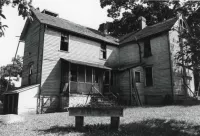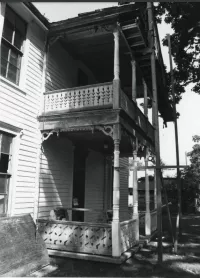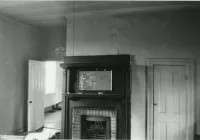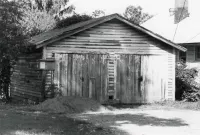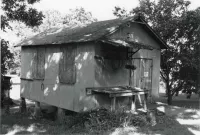Share what you know,
and discover more.
Share what you know,
and discover more.
Jan 21, 1994
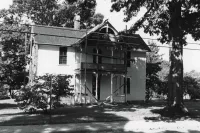
-

- Charmaine Bantugan
National Register of Historic Places - Thomas Jarrett House
Statement of Significance: The Thomas Jarrett House is eligible for listing in the National Register under criterion C for architecture. Built about 1894, the house is a remarkably intact example of a vernacular I-House form decorated with Queen Anne-style embellishments of the Victorian period. Now surrounded by bungalows and later twentieth-century residential architecture, the 1894 Jarrett House is a fine example of late nineteenth-century vernacular architecture that characterized that era's development in Asheville. Its builder and original owner were Thomas Jarrett, a millwright, woodworker, craftsman, and builder, who worked at the Clayton Mill in Asheville. Jarrett's occupation, as well as his skill as a craftsman, is reflected in the almost unchanged form and exuberant, nearly intact wooden detailing of his house. Architectural Context: The Thomas Jarrett House is a fine example of a local interpretation of popular Victorian architecture of the late nineteenth century. This vernacular architecture, as well as more refined "high" styles of design characterized Asheville's landscape at that time. The influence that popular architecture had on the builders of Asheville is evidenced by structures like the Jarrett House. While the plan of the house is typical of the period, the architectural woodwork that embellishes the exterior and interior of the house sets it apart. The basic I-house form contains extensive Queen Anne-inspired detailing and is representative of structures built in the Asheville area during the boom period dating from 1880 through the early 1900s. Perhaps the most striking element of architecture in Asheville at this time was the growing presence of ornamentation and prefabricated building components. This was a result of manufacturers creating architectural detailing that replaced the hand-carved elements of previous years, thus making these components more readily available and affordable to a wider variety of people (Bishir, North Carolina Architecture, page, 275). The Jarrett House belongs to a family of related structures built in Asheville at the turn of the century, including two houses at 71 West Street and Hillside Street. Both of these one-room-deep structures were built with similar Queen Anne detailing, especially in the gable ornamentation (Cabins and Castles, page 188-189). A significant feature of the Jarrett House, as well as others built at this time is continuation of the I-house form. The I-house forms found in Asheville echo one of the most prevalent house types found in rural Buncombe County. The widespread occurrence of the from throughout the county is demonstrated by the ca. 1880 Joseph Eller House near Weaverville, the ca. 1840 and 1890 Brigman- Chambers House near the Reems Creek community (that features an I- house built around an earlier log house), and ca. 1900 Joe E. Redman House near Juniper. All these rural examples, like the Jarrett House, feature two-tiered porches, although they are not as heavily decorated as that of the Jarrett House (Cabins and Castles, p. 114 and p. 116). The Jarrett house was constructed about 1894 by the owner, Thomas Jarrett. He was an accomplished wood wright, craftsman, and builder, who worked for the Clayton Mills, in Asheville. The mill had been established by Ephraim Clayton, who was a prominent builder in western North Carolina and was responsible for many structures there as well as in South Carolina and Georgia during the antebellum period and through Reconstruction. The 1860 Industrial Census reports show that his sash and blind mill on Valley Street was then operating. He was a proponent of industrializing mill operations to assist the Confederate army during the Civil War (Cabins and Castles, page, 68). Thomas Jarrett worked for the mill in the later years of the nineteenth century, and it is likely that the millwork for his house was patterned there. Clayton Mills participated in a building boom prompted in part by improved railroad service to Asheville. The construction industry in the city grew remarkably in the years between the Civil War and the turn of the century. Technology, quality, and quantity of construction continued to meet the demands of the increasing population. The Queen Anne-style ornamentation on the Jarrett house attests to early years of this boom, while the later part of it is characterized by the 1920s-era neighborhood surrounding it.
National Register of Historic Places - Thomas Jarrett House
Statement of Significance: The Thomas Jarrett House is eligible for listing in the National Register under criterion C for architecture. Built about 1894, the house is a remarkably intact example of a vernacular I-House form decorated with Queen Anne-style embellishments of the Victorian period. Now surrounded by bungalows and later twentieth-century residential architecture, the 1894 Jarrett House is a fine example of late nineteenth-century vernacular architecture that characterized that era's development in Asheville. Its builder and original owner were Thomas Jarrett, a millwright, woodworker, craftsman, and builder, who worked at the Clayton Mill in Asheville. Jarrett's occupation, as well as his skill as a craftsman, is reflected in the almost unchanged form and exuberant, nearly intact wooden detailing of his house. Architectural Context: The Thomas Jarrett House is a fine example of a local interpretation of popular Victorian architecture of the late nineteenth century. This vernacular architecture, as well as more refined "high" styles of design characterized Asheville's landscape at that time. The influence that popular architecture had on the builders of Asheville is evidenced by structures like the Jarrett House. While the plan of the house is typical of the period, the architectural woodwork that embellishes the exterior and interior of the house sets it apart. The basic I-house form contains extensive Queen Anne-inspired detailing and is representative of structures built in the Asheville area during the boom period dating from 1880 through the early 1900s. Perhaps the most striking element of architecture in Asheville at this time was the growing presence of ornamentation and prefabricated building components. This was a result of manufacturers creating architectural detailing that replaced the hand-carved elements of previous years, thus making these components more readily available and affordable to a wider variety of people (Bishir, North Carolina Architecture, page, 275). The Jarrett House belongs to a family of related structures built in Asheville at the turn of the century, including two houses at 71 West Street and Hillside Street. Both of these one-room-deep structures were built with similar Queen Anne detailing, especially in the gable ornamentation (Cabins and Castles, page 188-189). A significant feature of the Jarrett House, as well as others built at this time is continuation of the I-house form. The I-house forms found in Asheville echo one of the most prevalent house types found in rural Buncombe County. The widespread occurrence of the from throughout the county is demonstrated by the ca. 1880 Joseph Eller House near Weaverville, the ca. 1840 and 1890 Brigman- Chambers House near the Reems Creek community (that features an I- house built around an earlier log house), and ca. 1900 Joe E. Redman House near Juniper. All these rural examples, like the Jarrett House, feature two-tiered porches, although they are not as heavily decorated as that of the Jarrett House (Cabins and Castles, p. 114 and p. 116). The Jarrett house was constructed about 1894 by the owner, Thomas Jarrett. He was an accomplished wood wright, craftsman, and builder, who worked for the Clayton Mills, in Asheville. The mill had been established by Ephraim Clayton, who was a prominent builder in western North Carolina and was responsible for many structures there as well as in South Carolina and Georgia during the antebellum period and through Reconstruction. The 1860 Industrial Census reports show that his sash and blind mill on Valley Street was then operating. He was a proponent of industrializing mill operations to assist the Confederate army during the Civil War (Cabins and Castles, page, 68). Thomas Jarrett worked for the mill in the later years of the nineteenth century, and it is likely that the millwork for his house was patterned there. Clayton Mills participated in a building boom prompted in part by improved railroad service to Asheville. The construction industry in the city grew remarkably in the years between the Civil War and the turn of the century. Technology, quality, and quantity of construction continued to meet the demands of the increasing population. The Queen Anne-style ornamentation on the Jarrett house attests to early years of this boom, while the later part of it is characterized by the 1920s-era neighborhood surrounding it.
Jan 21, 1994
National Register of Historic Places - Thomas Jarrett House
Statement of Significance:The Thomas Jarrett House is eligible for listing in the National Register under criterion C for architecture. Built about 1894, the house is a remarkably intact example of a vernacular I-House form decorated with Queen Anne-style embellishments of the Victorian period. Now surrounded by bungalows and later twentieth-century residential architecture, the 1894 Jarrett House is a fine example of late nineteenth-century vernacular architecture that characterized that era's development in Asheville. Its builder and original owner were Thomas Jarrett, a millwright, woodworker, craftsman, and builder, who worked at the Clayton Mill in Asheville. Jarrett's occupation, as well as his skill as a craftsman, is reflected in the almost unchanged form and exuberant, nearly intact wooden detailing of his house.
Architectural Context:
The Thomas Jarrett House is a fine example of a local interpretation of popular Victorian architecture of the late nineteenth century. This vernacular architecture, as well as more refined "high" styles of design characterized Asheville's landscape at that time. The influence that popular architecture had on the builders of Asheville is evidenced by structures like the Jarrett House. While the plan of the house is typical of the period, the architectural woodwork that embellishes the exterior and interior of the house sets it apart. The basic I-house form contains extensive Queen Anne-inspired detailing and is representative of structures built in the Asheville area during the boom period dating from 1880 through the early 1900s. Perhaps the most striking element of architecture in Asheville at this time was the growing presence of ornamentation and prefabricated building components. This was a result of manufacturers creating architectural detailing that replaced the hand-carved elements of previous years, thus making these components more readily available and affordable to a wider variety of people (Bishir, North Carolina Architecture, page, 275).
The Jarrett House belongs to a family of related structures built in Asheville at the turn of the century, including two houses at 71 West Street and Hillside Street. Both of these one-room-deep structures were built with similar Queen Anne detailing, especially in the gable ornamentation (Cabins and Castles, page 188-189). A significant feature of the Jarrett House, as well as others built at this time is continuation of the I-house form. The I-house forms found in Asheville echo one of the most prevalent house types found in rural Buncombe County. The widespread occurrence of the from throughout the county is demonstrated by the ca. 1880 Joseph Eller House near Weaverville, the ca. 1840 and 1890 Brigman- Chambers House near the Reems Creek community (that features an I- house built around an earlier log house), and ca. 1900 Joe E. Redman House near Juniper. All these rural examples, like the Jarrett House, feature two-tiered porches, although they are not as heavily decorated as that of the Jarrett House (Cabins and Castles, p. 114 and p. 116).
The Jarrett house was constructed about 1894 by the owner, Thomas Jarrett. He was an accomplished wood wright, craftsman, and builder, who worked for the Clayton Mills, in Asheville. The mill had been established by Ephraim Clayton, who was a prominent builder in western North Carolina and was responsible for many structures there as well as in South Carolina and Georgia during the antebellum period and through Reconstruction. The 1860 Industrial Census reports show that his sash and blind mill on Valley Street was then operating. He was a proponent of industrializing mill operations to assist the Confederate army during the Civil War (Cabins and Castles, page, 68). Thomas Jarrett worked for the mill in the later years of the nineteenth century, and it is likely that the millwork for his house was patterned there. Clayton Mills participated in a building boom prompted in part by improved railroad service to Asheville. The construction industry in the city grew remarkably in the years between the Civil War and the turn of the century. Technology, quality, and quantity of construction continued to meet the demands of the increasing population. The Queen Anne-style ornamentation on the Jarrett house attests to early years of this boom, while the later part of it is characterized by the 1920s-era neighborhood surrounding it.
Posted Date
Aug 24, 2023
Historical Record Date
Jan 21, 1994
Source Name
National Register of Historic Places
Source Website
Delete Story
Are you sure you want to delete this story?


